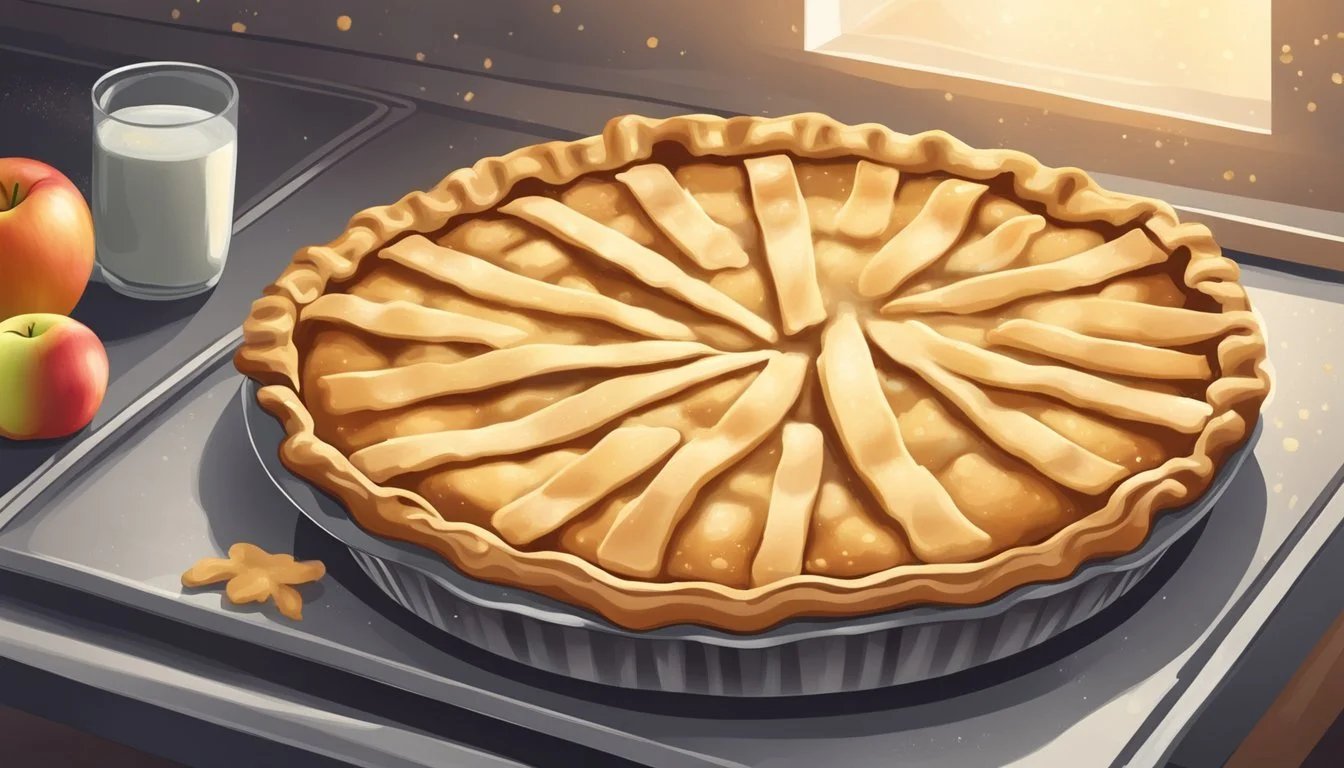Best Way to Reheat a Slice of Apple Pie
Tips for Preserving a Crisp Crust
When it comes to enjoying a slice of apple pie, the experience is often best when the pie is warm and the crust is perfectly crisp. However, reheating a slice can sometimes lead to a soggy crust or an unevenly warmed filling, which detracts from the pie's original charm. The key to reheating apple pie lies in the method chosen to warm it up, ensuring that the filling is heated through without compromising the texture of the crust.
Traditional ovens and skillets are the most common appliances for reheating apple pie. An oven provides a consistent all-around heat, while a skillet can give the crust the direct warmth it needs to maintain its crispness. The objective is to find a balance between a warm, gooey interior and a golden, flaky crust – aiming for that fresh-from-the-oven quality even on the second serving. With careful attention to temperature and timing, apple pie can be reheated to revive the delightful contrast of textures that makes this dessert so beloved.
Preparation for Reheating
Proper preparation is essential to ensure that a slice of apple pie is reheated without compromising its texture or flavor. This entails proper thawing if the apple pie was frozen and selecting an appropriate reheating method.
Thawing Process
If the apple pie is frozen, they should transfer it to the refrigerator to thaw slowly. Ideally, this should be done overnight to allow the pie to come to refrigerator temperature gradually. This minimizes the risk of a soggy crust and ensures an even reheating process.
For frozen apple pie: Move to the refrigerator and thaw overnight.
For leftover apple pie at room temperature: Proceed directly to reheating.
Choosing the Reheating Method
The objective is to warm the apple pie while maintaining a crisp crust and avoiding a dried-out filling. One must choose between using an oven or a skillet based on the tools available and personal preference.
Oven: Preheat to a moderate temperature, around 350°F (175°C). Place the slice on a baking sheet.
Skillet: Heat over medium, add the slice, cover to trap moisture and warmth.
It is not advisable to use a microwave, as it can soften the crust and lead to uneven heating.
Oven Reheating Method
Reheating a slice of apple pie in an oven can maintain the crispness of the crust while ensuring the filling is thoroughly warmed. One should carefully monitor temperature and use appropriate techniques to prevent a soggy crust.
Preheating the Oven
One must preheat the oven to 350°F before warming the pie. This temperature allows the pie to gradually reach the desired warmth without overcooking the crust or filling.
Steps for Preheating the Oven:
Turn on the oven.
Set the temperature to 350°F.
Allow the oven to heat up fully before placing the pie inside.
Using Baking Sheet for Optimal Heat Distribution
Placing the pie on a baking sheet improves heat distribution and adds sturdiness when moving the pie. For an even reheat, one can cover the pie with aluminum foil to protect the crust from burning.
Baking Sheet Setup:
Use parchment paper on the baking sheet for easy removal.
Position the apple pie slice in the center for uniform heating.
Preventing Soggy Crust
To prevent the pie crust from becoming soggy, one can utilize aluminum foil to cover the edges of the crust, shielding them from excess heat and retaining the texture.
Tips to Avoid Soggy Crust:
Cover the edges with strips of aluminum foil.
Remove the foil in the last few minutes if additional browning is needed.
Microwave Reheating Method
Reheating a slice of apple pie in the microwave can be a quick method if done right. Maintaining a crispy crust is achievable by setting the correct power level and using microwave-safe dishware.
Setting the Correct Power Level
To prevent the pie crust from becoming soggy when reheating, one should use a medium power setting. Most microwaves have a power range from low to high; select a medium setting or 50% power for optimal results. It's essential to heat the slice of pie gradually, as too much heat too quickly can soften the crust.
Power Level: Medium (50%)
Time: Heat in 30-second intervals
By controlling the power level, they ensure that the pie warms evenly without compromising the texture.
Using Microwave-Safe Dishware
For the best results, one must place the slice of apple pie on a microwave-safe plate or dish. Microwave-safe dishware is designed to withstand the heat and will not transfer any unwanted chemicals or flavors to the pie.
Dishware: Microwave-safe plate or dish
When they position the pie slice on the center of the plate, they facilitate even heating. If available, cover the slice with a microwave-safe lid or another plate to help retain moisture in the filling and prevent the crust from hardening.
Alternative Reheating Methods
While traditional oven reheating is commonplace, alternative methods can yield a crispy crust and warm apple pie interior. Each appliance offers a unique approach to achieve a desirable texture.
Air Fryer Use
An air fryer can reheat apple pie efficiently while enhancing crust crispness due to its rapid air circulation. For optimal results:
Temperature: Preheat the air fryer to 350°F.
Time: Reheat the slice for about 4-6 minutes.
Note: Check pie midway to avoid over-browning.
Skillet on Stovetop
A skillet on a stovetop mimics the even heating of an oven but with a focus on crisping the bottom crust.
Heat: Warm skillet over medium heat.
Cook Time: Place slice in the skillet, cover with a lid or foil, and heat for about 5 minutes.
Tip: For added flavor, a pat of butter can be melted in the skillet before adding the pie.
Toaster Oven Process
A toaster oven provides a more concentrated heat source, ideal for reheating pastries.
Temperature: Set to 350°F.
Time: Heat the slice for 10-15 minutes.
Check: Inspect the pie periodically to prevent the crust from hardening or burning.
Post-Reheating Tips
After reheating, the goal is to preserve the slice's texture and amplify its flavors. Proper serving and storage are key to enjoying the warm apple pie to its fullest.
Serving Suggestions
One may elevate their dessert experience by serving the reheated slice of apple pie with a dollop of whipped cream or a scoop of vanilla ice cream. These additions complement the warmth of the pie and the richness of the fruit filling, creating a balanced and indulgent dessert. It's essential to serve the pie immediately after reheating to maintain the crispness of the crust.
Storing Leftovers
In the event of any leftovers, one should store them properly to retain the pie's quality. Here are some steps for effective storage:
Allow the pie to cool completely before storage.
Wrap the slice tightly with plastic wrap or aluminum foil.
Place it in an airtight container to maintain freshness.
Refrigerate for up to 3-4 days.
When one needs to reheat the slice again, they should follow the original reheating instructions to ensure the crust remains crisp.
Special Considerations
In the quest for the perfect reheated slice of apple pie, it's important to account for unique scenarios such as working with frozen pies and the characteristics of double-crusted pies to avoid a soggy or lackluster crust.
Reheating Frozen Apple Pie
When dealing with a frozen apple pie, patience is crucial. It's advisable to first thaw the pie in the refrigerator for 24 hours to avoid a thermal shock to the pastry. During reheating, the pie should be covered loosely with foil to prevent the crust from burning and baked in an oven preheated to 350°F (175°C) for about 30 minutes or until the center is warm. This gradual process helps ensure that the crust remains crisp and the filling, evenly heated.
Working with Double-Crusted Pies
Double-crusted pies pose their own challenge because of the additional layer of pastry. When reheating, a low and slow approach in the oven at 300°F (150°C) helps preserve the texture of both the top and bottom crusts. If one notices that the edges are browning too quickly, they can be protected by wrapping strips of aluminum foil around the pie's perimeter. A reheating time of 15 to 20 minutes should suffice, but it's important to keep a close eye to prevent the pie from becoming soggy.
Troubleshooting
Reheating a slice of apple pie requires attention to detail to maintain the perfect balance between a crispy crust and a warm, savory filling. The following subsections address common reheating pitfalls and methods to ensure the crust's crispiness is preserved.
Avoiding Common Mistakes
Pie Preparation: Prior to reheating, ensure the apple pie has been stored correctly. Improper storage can lead to a soggy crust even before reheating begins.
Oven Temperature: Set the oven no higher than 350°F (175°C). Excessive heat may compromise the crust.
Reheating Time: Be vigilant about the time the pie spends in the oven. Overheating can dry out the pie filling and thicken it excessively, making it gummy rather than soft and luscious.
Ensuring Crust Crispiness Upon Reheating
Covering Techniques: Loosely tent the slice of apple pie with foil when reheating to prevent the crust from browning too much while allowing the pie filling to heat throughout.
Placement in Oven: Place the pie on a lower rack to focus heat on the bottom crust, helping it crisp up without burning the top.
Use of Baking Sheet: A preheated baking sheet aids in instantly delivering heat to the crust, reinforcing its crispness from the moment it's placed in the oven.
FAQs
In maintaining the quality and safety of a reheated slice of apple pie, it's essential to follow best practices and consider health concerns. This ensures that one's comfort food cravings are met with the same delight as when freshly baked.
Safety and Health Concerns
When reheating leftover apple pie, the primary health concern is ensuring that it's heated to a safe temperature to avoid the risk of foodborne illnesses. The pie should reach an internal temperature of 165°F throughout to ensure that it is safe to consume. Never consume apple pie that has an off smell or appearance, as this indicates spoilage.
Freezing Apple Pie: If one wishes to store a slice of apple pie for an extended period, freezing is an option. To freeze, wrap the pie securely and consume within 4 months for best quality. Always thaw frozen apple pie in the refrigerator before reheating.
Reheating Methods: It is recommended to reheat a slice of apple pie on a baking sheet in an oven preheated to 350°F until warmed through. This maintains a crisp crust and even heating.
Best Practices
The following best practices will ensure a slice of apple pie is reheated thoroughly while keeping the crust crisp and delicious:
Using a Baking Sheet: Place the slice on a parchment-lined baking sheet. This allows the heat to distribute evenly, preventing a soggy bottom.
Temperature and Duration: Preheat the oven to 350°F. Reheat the pie for approximately 10 minutes. Use a food thermometer to check that the filling has reached the recommended temperature.
Keeping the Crust Crisp: Brushing an egg wash over the crust before reheating can help keep it crisp. Alternatively, using a pie shield or foil to cover the edges of the crust can prevent overbrowning.
When done properly, reheating apple pie can restore the inviting allure of the holiday classic, even after the event, like Thanksgiving, has passed. Follow the simple steps above to enjoy a slice that's as appealing as it was when it first emerged from the oven.






